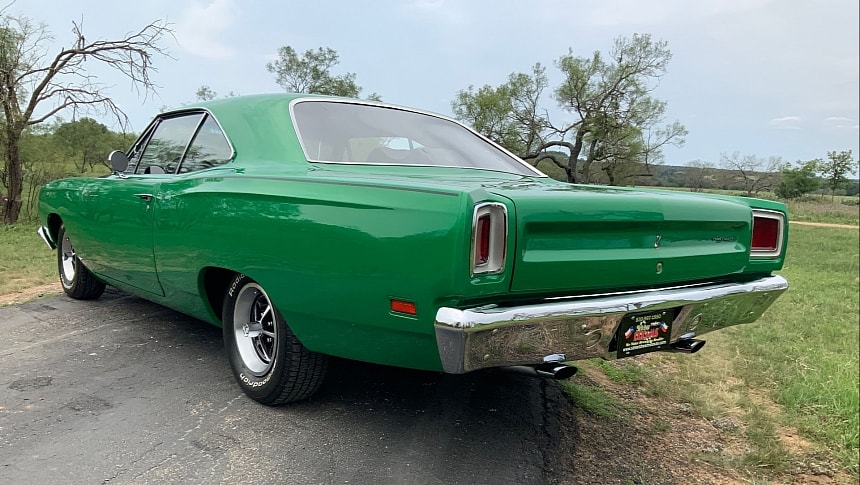Introduced for the 1968 model year, the Plymouth Road Runner became a big hit thanks to its performance-oriented nature and affordable sticker. Following a shortened debut year, the Road Runner found 81,105 homes in 1969, outselling the Dodge Super Bee by nearly three to one.
The most popular iteration of the Road Runner, the 1969 version is a rather common classic nowadays. Of course, this statement excludes the HEMI, produced in 787 units, and the 440 Six-Pack, made in 1,412 examples. The convertible is also scarce at 1,890 units, regardless of the drivetrain lineup.
The 383-equipped Road Runner, on the other hand, saw daylight in a whopping 77,026 examples (not including drop-tops). But that's not to say that all 1969 Road Runners packing 383-cubic-inch (6.3-liter) big-block V8s are mundane. Some were specified with certain options that make them rarer than the average rig, while others got a few aftermarket touches. This Rallye Green example has both.
The most obvious feature that sets it apart is the N96-coded Air Grabber hood. There's no info on how many 383 cars were ordered with these now-desirable items, but it's safe to say the Air Grabber hood isn't a common feature with this powerplant. The Road Runner also appears to sit a tad lower than its stock siblings, but most upgrades are hidden under the metallic green shell.
For starters, the 383 V8 got a couple of notable improvements. It has a four-barrel Holley carburetor under the "Coyote Duster" air cleaner, while the factory intake manifold was replaced with an aluminum Edelbrock Performer 383 unit. The latter is said to greatly improve torque over a wide rpm range for better throttle response.
But the most notable upgrade lurks inside the cabin because the owner took the Road Runner's rather mundane interior up a notch with leather upholstery, green stitching, and matching Road Runner motifs. These are visible as soon as you open the door to reveal panels with center sections in crocodile-skin patterns and green Road Runner characters sewn near the window cranks.
The seats have a similar layout, plus green-stitched stripes separating the sides from the center sections. Moreover, the rear compartment now features two seats instead of the usual bench. On the flip side, the big hump between them is a bit unpleasant to the eyes. More green road runner figures are sewn into the custom floor mats and between the rear seats.
Upgrades aside, this Road Runner appears to be in pristine condition, probably due to a recent restoration. The VIN confirms it's a factory hardtop (RM23). The 383 V8 mates to a four-speed manual gearbox, which makes this Road Runner one of 21,278 units built with this body style and drivetrain layout in 1969. Check it out in the video below.
The 383-equipped Road Runner, on the other hand, saw daylight in a whopping 77,026 examples (not including drop-tops). But that's not to say that all 1969 Road Runners packing 383-cubic-inch (6.3-liter) big-block V8s are mundane. Some were specified with certain options that make them rarer than the average rig, while others got a few aftermarket touches. This Rallye Green example has both.
The most obvious feature that sets it apart is the N96-coded Air Grabber hood. There's no info on how many 383 cars were ordered with these now-desirable items, but it's safe to say the Air Grabber hood isn't a common feature with this powerplant. The Road Runner also appears to sit a tad lower than its stock siblings, but most upgrades are hidden under the metallic green shell.
For starters, the 383 V8 got a couple of notable improvements. It has a four-barrel Holley carburetor under the "Coyote Duster" air cleaner, while the factory intake manifold was replaced with an aluminum Edelbrock Performer 383 unit. The latter is said to greatly improve torque over a wide rpm range for better throttle response.
But the most notable upgrade lurks inside the cabin because the owner took the Road Runner's rather mundane interior up a notch with leather upholstery, green stitching, and matching Road Runner motifs. These are visible as soon as you open the door to reveal panels with center sections in crocodile-skin patterns and green Road Runner characters sewn near the window cranks.
The seats have a similar layout, plus green-stitched stripes separating the sides from the center sections. Moreover, the rear compartment now features two seats instead of the usual bench. On the flip side, the big hump between them is a bit unpleasant to the eyes. More green road runner figures are sewn into the custom floor mats and between the rear seats.
Upgrades aside, this Road Runner appears to be in pristine condition, probably due to a recent restoration. The VIN confirms it's a factory hardtop (RM23). The 383 V8 mates to a four-speed manual gearbox, which makes this Road Runner one of 21,278 units built with this body style and drivetrain layout in 1969. Check it out in the video below.














